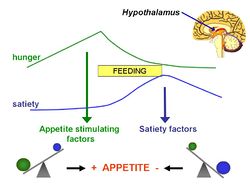Energostatic hypothesis
For the course duration, the article is closed to outside editing. Of course you can always leave comments on the discussion page. The anticipated date of course completion is 01 April 2012. One month after that date at the latest, this notice shall be removed. Besides, many other Citizendium articles welcome your collaboration! |
The energostatic hypothesis is based on the idea that, because the brain controls eating, it seems reasonable that hunger might be triggered by a decrease in the availability of energy for the brain itself.[1]
Plan For Article
==Introduction== How Booth originally came up with the idea for the energostatic hypothesis and his original research methods. Include a timeline diagram here to illustrate the research progress and highlight key areas of progress or new ideas that have changed the original hypothesis. This can also be used to demonstrate current research being undertaken and any significant findings.
==The dynamic between Glucose and Lipid systems== Each will have its own sub-section to explain their different mechanisms in triggering the hypothesis and finally how they both combine together to produce the overall effect. A diagram could be used here to illustrate the mechanism of the role of AMPK and how it works.
==Where is this mechanism triggered?== A lot of research has been conducted into the important of hepatic regulation into energy metabolism. Is this the main sensing organ or are higher centres more crucial in this process.
==Short/Long term benefits== We know that the energostatic hypothesis allows satiety for a period of time but are there any long-term benefits to this mechanism.
==Current or Future Directions== The theory that AMPK could be used as a potential drug target for combatting obesity. The importance of the Leptin and Ghrelin in changing the perceptions of the hypothesis. Is it still a relevant theory?
References
- ↑ Booth DA (1972) Postabsorptively induced suppression of appetite and the energostatic control of feeding Physiol Behav 9:199–202 PMID 4654732
